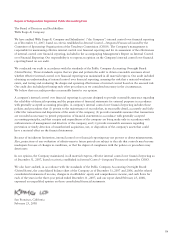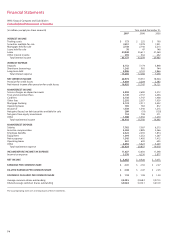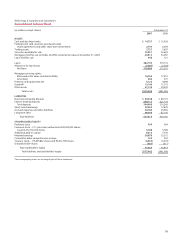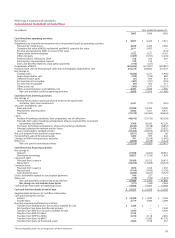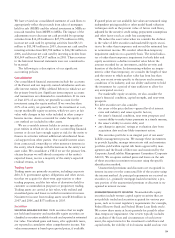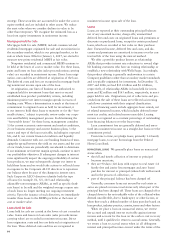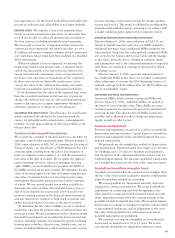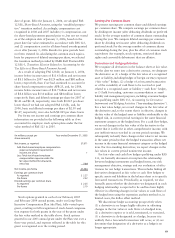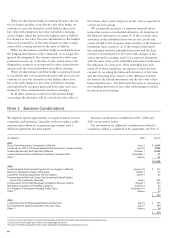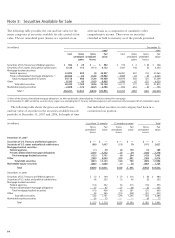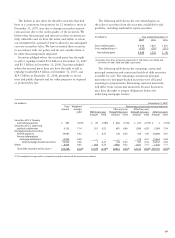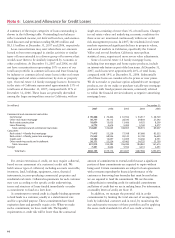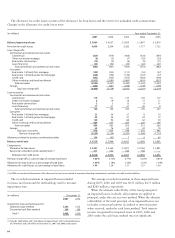Wells Fargo 2007 Annual Report Download - page 85
Download and view the complete annual report
Please find page 85 of the 2007 Wells Fargo annual report below. You can navigate through the pages in the report by either clicking on the pages listed below, or by using the keyword search tool below to find specific information within the annual report.82
or changes in circumstances indicate that their carrying
amounts may not be recoverable. Impairment is indicated
if the sum of undiscounted estimated future net cash flows
is less than the carrying value of the asset. Impairment is per-
manently recognized by writing down the asset to the extent
that the carrying value exceeds the estimated fair value.
Operating Lease Assets
Operating lease rental income for leased assets, generally
autos, is recognized in other income on a straight-line basis
over the lease term. Related depreciation expense is recorded
on a straight-line basis over the life of the lease, taking into
account the estimated residual value of the leased asset.
On a periodic basis, leased assets are reviewed for impair-
ment. Impairment loss is recognized if the carrying amount
of leased assets exceeds fair value and is not recoverable.
The carrying amount of leased assets is not recoverable if it
exceeds the sum of the undiscounted cash flows expected to
result from the lease payments and the estimated residual
value upon the eventual disposition of the equipment. Leased
assets are written down to the fair value of the collateral less
cost to sell when 120 days past due.
Pension Accounting
We account for our defined benefit pension plans using an
actuarial model required by FAS 87, Employers’ Accounting
for Pensions, as amended by FAS 158, Employers’ Accounting
for Defined Benefit Pension and Other Postretirement Plans –
an amendment of FASB Statements No. 87, 88, 106, and
132(R). This model allocates pension costs over the service
period of employees in the plan. The underlying principle is
that employees render service ratably over this period and,
therefore, the income statement effects of pensions should
follow a similar pattern.
FAS 158 was issued on September 29, 2006, and became
effective for us on December 31, 2006. FAS 158 requires us
to recognize the funded status of our pension and postretire-
ment benefit plans on our balance sheet. Additionally, FAS
158 will require us to use a year-end measurement date
beginning in 2008. We conformed our pension asset and our
pension and postretirement liabilities to FAS 158 and record-
ed a corresponding reduction of $402 million (after tax) to
the December 31, 2006, balance of cumulative other com-
prehensive income in stockholders’ equity. The adoption of
FAS 158 did not change the amount of net periodic benefit
expense recognized in our income statement.
One of the principal components of the net periodic pen-
sion expense calculation is the expected long-term rate of
return on plan assets. The use of an expected long-term rate
of return on plan assets may cause us to recognize pension
income returns that are greater or less than the actual returns
of plan assets in any given year.
The expected long-term rate of return is designed to
approximate the actual long-term rate of return over time
and is not expected to change significantly. Therefore, the
pattern of income/expense recognition should closely match
the stable pattern of services provided by our employees over
the life of our pension obligation. To determine if the expected
rate of return is reasonable, we consider such factors as
(1) long-term historical return experience for major asset
class categories (for example, large cap and small cap
domestic equities, international equities and domestic fixed
income), and (2) forward-looking return expectations for
these major asset classes. Differences in each year, if any,
between expected and actual returns are included in our net
actuarial gain or loss amount, which is recognized in other
comprehensive income. We generally amortize any net actu-
arial gain or loss in excess of a 5% corridor (as defined in
FAS 87) in net periodic pension expense calculations over
the next five years.
We use a discount rate to determine the present value of
our future benefit obligations. The discount rate reflects the
rates available at the measurement date on long-term high-
quality fixed-income debt instruments and is reset annually
on the measurement date (November 30). In 2008, we will
use December 31 as our measurement date as required under
FAS 158.
Income Taxes
We file a consolidated federal income tax return and, in
certain states, combined state tax returns.
We account for income taxes in accordance with FAS
109, Accounting for Income Taxes, as interpreted by FIN 48,
resulting in two components of income tax expense: current
and deferred. Current income tax expense approximates
taxes to be paid or refunded for the current period and
includes income tax expense related to our uncertain tax
positions. We determine deferred income taxes using the bal-
ance sheet method. Under this method, the net deferred tax
asset or liability is based on the tax effects of the differences
between the book and tax bases of assets and liabilities, and
recognizes enacted changes in tax rates and laws in the period
in which they occur. Deferred income tax expense results
from changes in deferred tax assets and liabilities between
periods. Deferred tax assets are recognized subject to man-
agement’s judgment that realization is more likely than not.
A tax position that meets the “more likely than not” recogni-
tion threshold is measured to determine the amount of bene-
fit to recognize. The tax position is measured at the largest
amount of benefit that is greater than 50% likely of being
realized upon settlement. Foreign taxes paid are generally
applied as credits to reduce federal income taxes payable.
Interest and penalties are recognized as a component of
income tax expense.
Stock-Based Compensation
We have stock-based employee compensation plans, as
more fully discussed in Note 19. Prior to January 1, 2006,
we accounted for stock options and stock awards under the
recognition and measurement provisions of Accounting
Principles Board Opinion No. 25, Accounting for Stock Issued
to Employees (APB 25), and related interpretations, as permitted
by FAS 123, Accounting for Stock-Based Compensation. Under
this guidance, no stock option expense was recognized in our
income statement for periods prior to January 1, 2006, as all
options granted under our plans had an exercise price equal
to the market value of the underlying common stock on the



